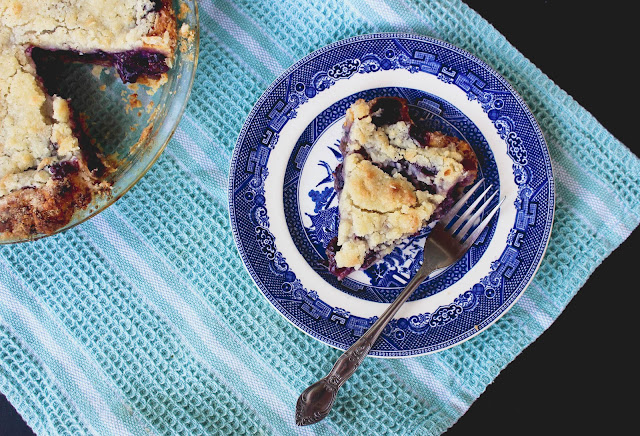
I've had a few brushes with grape pie, but had never actually made or eaten one before, at least of the Concord variety. When I lived in North Carolina, I made a Muscadine Hull Pie, with the skins of the sweet, round fig-purple grapes that grow in the area. As for pie of the Concord variety, I'd first heard of it back in 2009, when my friend Angela shared a post here of a version her friend illustrator Jill Bliss had made. A few years later, my parents sent me a souvenir bumper sticker and children's book from Monica's Pies in Naples, New York, after becoming devotees of her signature grape dessert while on a road trip through the state.

As it turns out, Naples, New York is essentially grape pie ground zero. There in the western side of the state, along the Finger Lakes, Concord grapes grow extremely well and much of the region's economy relies on their production and byproducts (read: wine). Grape pie in particular rose to prominence there in the early 1960s when Al Hodges, the owner of Redwood Restaurant began offering a version, made from a recipe he picked up from a local German woman (grape pie is thought to be a German recipe). Demand for the dessert soon outgrew the restaurant kitchen, so Hodges hired Irene Bouchard, now known as the mother of Naples' grape pies. She started a small business out of her home which at its peak, produced 6,000 grapies each season. Bouchard passed away last year at the age of 98.
The Concord grape region where Naples is located actually stretches from Western New York and into Pennsylvania, Ohio, and Michigan. It's within that region that we can situate Jake's grandmother Anna Gillen. Here's what Jake told me about Anna:
"Anna (nee Welsh) Gillen, was born in Hazelton, Pennsylvania, in 1919 and grew up in the Anthracite coal patches of Northeastern Pennsylvania (specifically Jeddo and Freeland). She moved to Bethlehem in her late teens as mining towns were declining and tons of people were finding work with Bethlehem Steel. Mother of 5, and a bank teller, she loved math and always wanted to be a teacher, but never was. She did a lot of baking until her death in 2011. Her oatmeal raisin cookies will never be beat, nor will her apple crumb pie." Turns out, her grape pie won't be either.

I finally got my hands on some Concord grapes this year, and made Anna's recipe. I was initially dubious of the crumble crust, not for taste-sake, but because I wanted to make sure the deep purple hue was visible in the pie. But I found the crumble to be an essential part of the recipe, counteracting the tartness of the grapes with its sweetness, and adding a sand-sugar texture to the syrupy filling. The flavor is rich and aromatic and evocative-- of memories drinking Concord grape juice with mom and grandmother's delicious secrets, of enterprising home bakers and vineyards running through the middle of the country, of a yearly fall ritual I may need to adopt for my own.

Adapted from Jake Hoffman's grandmother's recipe
Ingredients
For the pie:
Nothing in the House pie crust, halved
4 cups or 2-2 1/2 pounds Concord grapes
1/4-1/3 cup granulated sugar, depending on sweetness of grapes
1/3 cup all-purpose flour
1/4 teaspoon salt
1 Tablespoon fresh lemon juice
2 Tablespoons unsalted butter, melted
For the topping:
1/2 cup all-purpose flour
1/2 cup granulated sugar
1/3 cup unsalted butter
Directions
1. Prepare half of Nothing in the House pie crust as per the directions, reserving the leftover egg for an egg wash and saving other half of the recipe in the freezer for a future pie. Chill dough at least one hour before rolling and fitting into a greased and floured 9-inch pie pan. Wrap with plastic wrap and place in fridge until ready to use.
2. Preheat oven to 400 degrees F. Pop grapes put of their skin and separate pulp and skin into two medium-sized bowls. Place pulp in a medium-sized saucepan and bring to a boil. Once boiling, reduce heat and simmer uncovered, 5 minutes. Run pulp through a seive or food mill to remove seeds.
3. Place de-seeded pulp into the bowl with the grape skins. In a separate bowl, stir together sugar, flour, and salt to combine. Add the lemon juice and melted butter to dry ingredients, then mix into the grape mixture.
4. Pour the filling into the pie crust and brush crust with reserved egg wash. Place pie pan on a cookie sheet and bake sans crumble top for 25 minutes at 400 degrees. Meanwhile, prepare the topping by stirring together flour and sugar, and cutting in the butter until coarse crumbs form. Keep in fridge until ready to use.
5. After 25 minutes, remove topless pie from the oven and scatter the crumb topping over the grape filling. Return to oven for 15-25 more minutes until filling is bubbling and crust is golden brown. Enjoy!





